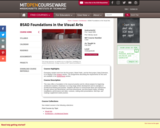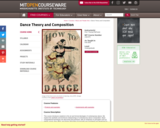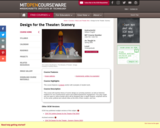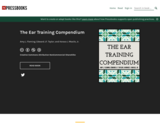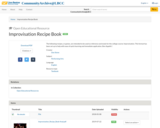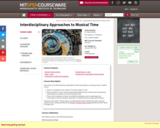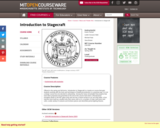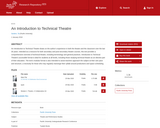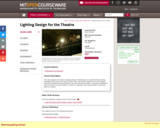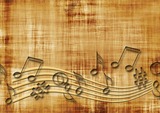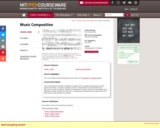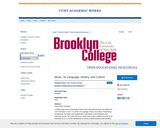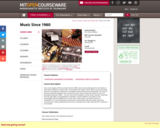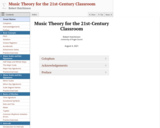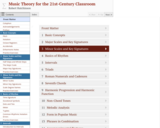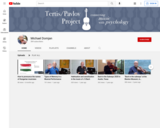NOTE: Note, if you cannot see the materials, click "View Resource" and then click "Link" on the blank page which appears (or go directly to http://musictheory.tech).
This open educational resource (OER) textbook which is available at http://musictheory.tech contains an explanation of concepts from Music Theory I, II, III, and IV. It is supplemented by video explanations and online assessment activities. It is available at no cost for students and faculty of music theory so long as they use it according to the terms. The copyright notice must not be removed and the terms of distribution may not be changed. Derivative works are permitted under the same terms. Derivative works must be registered by email to editor@musictheory.tech. The concise nature of the materials makes them especially useful for those wishing to review theory concepts before taking an entrance exam, or for students needing out-of-class review of theory topics. The book and materials are under active development and suggestions for improvements are welcome! The materials were created with partial support from an OER grant from Tarleton State University. Floyd Richmond the author has taught college-level music theory I, II, III, and IV for 15 years to hundreds of students.
The supplemental videos and interactive assessments are found in the text but are extracted and listed online at http://musictheory.tech.
The following list of concepts extracted from the Table of Contents shows the scope of the textbook.
THEORY I
WHY IS MUSIC THEORY IMPORTANT
MUSIC THEORY THROUGHOUT HISTORY
WHICH NOTE TO PLAY
Staff, Clef, Treble (G), Bass (F), Alto (C), Tenor (C), Ledger Lines, Octaves
NAMING THE NOTES
ACCIDENTALS
Lines, Space, Accidentals, Sharps, Flats, Naturals, Double Sharps, Double Flats, Octave Numbers
RHYTHM
Note Shape, Heads, Stems, Beams, Rhythmic Names, Duration
STEM DIRECTION
Stem Direction, Special Cases, Center Line, Beamed Notes)
RHYTHMIC RELATIONSHIPS
Whole Notes, Half Notes, Quarter Notes, Eighth Rests, Sixteenth Notes
Whole Rests, Half Rests, Quarter Rests, Eighth Rests, Sixteenth Rests
PATTERNS AND COUNTING
One Beat Patterns, Two Beat Patterns, Kodaly, Gordan, Traditional
METER AND TIME SIGNATURES
Meter, Quadruple Meter, Triple Meter, Duple Meter, Conducting Patterns
PICKUP NOTES
Anacrusis, Conducting
MORE ABOUT TIME SIGNATURES
Common Time, Rhythmic Durations, Time Signatures with a 2, 4, or 8 on the bottom, Simple meter, 2/4, 3/4, 4/4
COMPOUND TIME SIGNATURES
6/8, 9/8, 12/8
DOTTED NOTE VALUES
Dotted Quarter/Eighth, Dotted Eighth/Sixteenth
TIES
SLURS
REPEATS
One-measure Repeats, Two measure Repeats, Simple Repeats, First and Second Endings, DC al Fine, DS al fine, DC al Coda, DS al Coda
MAJOR SCALES
Chromatic Scale, Major Scale, Solfege, do, re, mi, fa, sol, la, ti, do, Fixed and Movable do, Whole and Half Steps in a Major Scale
KEY SIGNATURES
Order of Sharps and Flats, Mnemonic Devices, Placement on the Staff, 15 Major Key Names and Number of Sharps and Flats
TONALITY
MINOR SCALES
Natural, Harmonic, and Melodic Minor Scales, Construction, 15 Mine Key Names and Number of Sharps and Flats
MODES
Minor Modes: Aeolian, Dorian, Phrygian; Major Modes: Ionian, Lydian, Mixolydian; Other Modes: Locrian; Other Scales: Pentatonic, Whole Tone, Octatonic, Pitch Class Set, Chromatic
INTERVALS
Consonant Intervals, Dissonant Intervals, Neutral Intervals, Melodic Intervals, Harmonic Intervals, Unison, 2nd, 3rd, 4th, 5th, 6th, 7th, Octave, Qualities of Interval: Major, Minor, Perfect, Diminished, Augmented, Doubly Diminished, Doubly Augmented, Listening to Intervals, Enharmonically Equivalent Intervals, Most Consonant, Neutral, and Dissonant Intervals, Inverting Intervals, Identifying Intervals, Constructing Intervals
SCALE DEGREE NAMES
Tonic, Supertonic, Mediant, Sub Dominant, Dominant, Submediant, Leading Tone, Sub Tonic
TRIADS
Major (Mm), Minor (mM), Diminished (mm), Augmented (MM), Arrangement on Scale Steps in Major Keys, Arrangement on Scale Steps in Minor Keys, Identifying Triads, Spelling Triads
CHORD SYMBOLS FOR TRIADS
Popular Music Conventions, Roman Numeral Conventions
TRIAD INVERSION
Root Position – Bass Note: Root, First Inversion (6) Bass Note: Third, Second Inversion (64) Bass Note: Fifth
HARMONIC PROGRESSIONS
Dominant to Tonic Movement, Circle of Fifths, . . . iii, vi, ii, V I . . .
CHORD SUBSTITUTIONS
Chords with Shared Notes, Common Chord Substitutions
MORE ABOUT CHORD PROGRESSIONS
Chord Substitutions in Major and Minor Keys, I64 as a dominant substitution, Cadential 64 Progressions
WRITING MUSIC
Rhythms, Melodies, Harmonies, Texture, Form
CREATING HARMONIES
Two Voices, Three Voices, Four Voices, Voice Leading Rules, Resolving Adjacent Chords, Resolving Chords with Tendency Tones
NON-CHORD TONES
Passing Tone, Neighboring Tone, Appoggiaturas, Escape Tones, Anticipations, Suspensions, Retardations, Pedal Tones, Suspension Numbers, Identifying, Constructing
CADENCES
Function of Cadences, Types of Cadences: Authentic Cadences, Perfect Authentic Cadences, Imperfect Authentic Cadences, Plagal Cadences, Half Cadences, Deceptive Cadences; Strength of Cadences
PERIOD AND PHRASE CONSTRUCTION
Phrases, Periods, Double Periods, Antecedent, Consequent, Parallel Construction
THEORY II
SEVENTH CHORDS
M7 (MmM), Mm7 (Mmm), m7 (mMm), Æ7 (mmM), °7 (mmm), Writing Quality with Popular and Roman Numeral Systems
SEVENTH CHORD INVERSION
Root Position (7), First Inversion (65), Second Inversion (43), Third Inversion (42), Popular and Roman Numeral Conventions, Seventh Chord Progressions, Substitutions, Doubling, Resolving, Identifying, Construction, Using 9th, 11th, and 13th Chords
SECONDARY DOMINANTS
Concept, Purpose, Circle of Fifths, Major and Minor Keys, Identification, Construction, Resolution
SECONDARY SEVENTH CHORDS
Concept, Purpose, Identification, Construction, Resolution
THEORY III
MODULATIONS
Pivot Chords, Common Tones, Direct Modulations
BORROWED CHORDS
PREDOMINANT CHORDS
Neapolitan 6 (N6), Augmented Chords: German (G+6), Italian (I+6), French (F+6), Other +6 Chords, Enharmonic Spelling, Identification, Constructions, Resolution, Secondary Augmented Sixth Chords
THEORY IV
LATE ROMANTIC AND IMPRESSIONISTIC PRACTICES
More Substitute Chords, ct°7, Parallel Chords, Planing, Chromatic Mediants, Whole Tone Scales, Octatonic Scales, Pentatonic Scales, Modal Scales, Modified Modal Scales, Making Dissonances Approachable
TWENTIETH CENTURY AND BEYOND
TWENTIETH CENTURY CLASSICAL MUSIC
Meter (Changing Meters, Asymmetric Meters, Bimetric, Polymetric), Tonality (Bitonality, Polytonality), Non-Tertian Harmony (Tone Clusters, Secundal Harmony, Quartal Harmony, Quintal Harmony), Pandiatonic Harmony, Minimalism, Expressionism/Serialism, Aleatoric Music, Prepared Piano, Music Concrete, Electronic Music
JAZZ
Origins, Influences, Vocabularies, Melodies, Rhythms, Expression, Harmony
POP MUSIC
Decades, Instruments (Folk, Clean Electric, Distorted Electronic, Keyboards, Bass, Drums, Vocals), Harmonies, Memorization, Modulations, Forms, Timbres
FORMS
Binary, Ternary, Round/Canon, Invention, Fugue, Passacaglia, Minuet, Theme and Variation, Rondo, Sonata Allegro, Tone Poem
